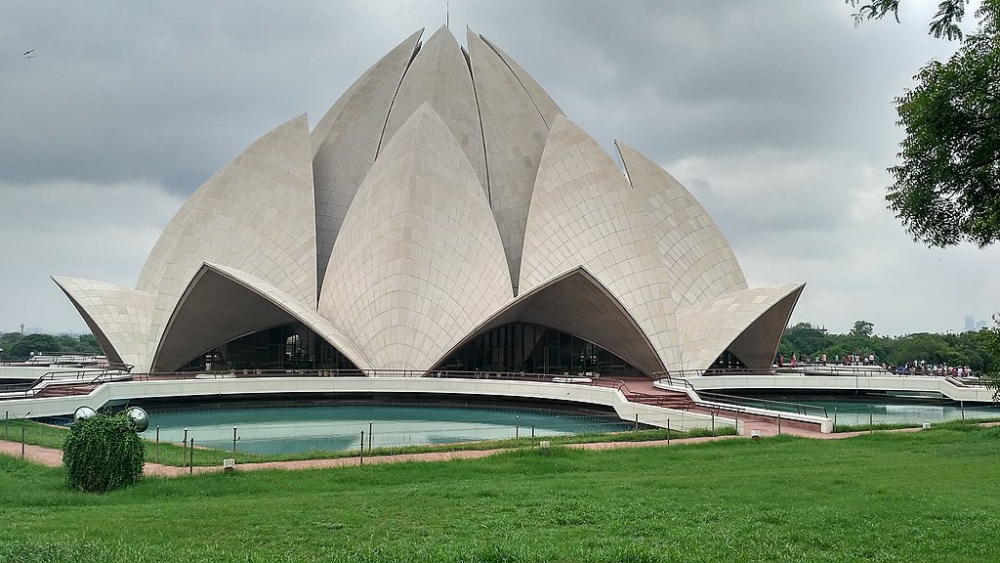The Lotus Temple is one of the most remarkable monuments in New Delhi. It has received various international awards for its architecture and attracts numerous people of all religions and faiths each day. While a lot of us know about its lotus-like appearance, there are many other aspects to its grandiose design that make it a fascinating monument. (Photo Courtesy: User- (WT-shared) Jpatokal at wts wikivoyage [CC BY-SA 4.0])
For anyone exploring Delhi’s stunning architecture, there is no dearth of options of places to explore and admire. However, most of these marvels were constructed in pre-independent India. The intriguing flower-like Lotus Temple, located on the western bank of the Yamuna river, is a notable exception. This grand monument, designed by the Iranian architect Fariborz Sahba and completed in 1986, has arguably the most fascinating design out of the 10 Mashriqu’I-Adhkar (Baha’i Houses of Worship) across the world. No wonder, a 2001 CNN report listed it as one of the most visited buildings in the world.[1] The Baha’i faith can be traced to mid-19th century Iran. It branched out of the Babi religion established by Mirza Ali Muhammad, also known as the Bab (the gate, in Arabic). The Baha’i Houses of Worship are spread all around the world and are located in cities such as Sydney (Australia), Panama City (US), Wilmette (US) and Langenhain (Germany).
Going by Numbers
The lotus motif is not unique to India though when used in architecture elsewhere, it might not be as ornate. The central lotus-like architecture of the temple is also found, somewhat vaguely, in the Baha’i temples of Germany, Chile, Cambodia and Colombia. The followers of the Baha’i faith regard the lotus as a symbol of purity, beauty and divinity. The temple in Delhi was constructed using concrete, glass, steel and marble, and is situated on a podium. Spread over 26 acres, the complex houses a reception centre, a library, an administrative building and has numerous gardens and pools. Similar to other Baha’i temples, this structure has the signature nine-sided construction, as the number nine is considered special by the Baha’i followers, who believe that nine is the last single-digit number and symbolises completeness.[2]

The Lotus Temple boasts of 27 independent marble petals that have been grouped into clusters of three, thus forming its nine sides (Courtesy: Buete [CC BY-SA 4.0])
The Lotus Temple consists of 27 independent marble petals grouped into clusters of three to form its nine sides. The outermost set of nine shells, called the entrance leaves, opens outwards and forms the nine entrances to the outer annular hall. The next set of nine petals, called the outer leaves, points inwards. The third and final set of petals appears to be partly closed and curves to enclose the central prayer hall, which can accommodate about 2,500 people.[3] Inside the prayer hall, set at the top is the Baha’i ringstone symbol, which represents the world of God, the world of his manifestations, and the world of humankind, along with a nine-pointed star which emphasizes the importance of the number nine in the religion.
Syncretised Design
Architect Sahba studied the various temples of South Asia to imbibe maximum influence from India’s rich culture. The lotus motif was derived from the Ajanta and Ellora Caves, which show the throne of avatars through lotus impressions.[4] Similarly, he drew inspiration from Buddhist architecture, which portrays deep reverence for the lotus motif especially in the depiction of Avalokiteswara (one of the bodhisattvas, or the previous incarnations of Buddha before he gained enlightenment).[5] He, thus, combined the notion of purity and tenderness of the Baha’i faith with the historical architectural features of Indic aesthetics to construct this modern-day wonder.
Its syncretised design aims at promoting peace, for which it has won numerous awards, including the First Honor award for ‘Excellence in Religious Art and Architecture’ from the Interfaith Forum on Religion, Art and Architecture Affiliate of the American Institute of Architects in 1987, and the GlobArt Academy award in 2000.[6]
In Iran, the Baha’i faith, which teaches the essential worth of all religions, promotes a rational and modern outlook to religious practice. This is one of the reasons why the Lotus Temple in Delhi does not discriminate on the basis of religion, and is open to all. The significance of the Lotus Temple lies in the spirit of tolerance that the Baha’i faith displays towards practitioners of various religions.
A Symbol of Tolerance
The followers of the Baha’i faith have been present in India since the late 19th century. This unique community has found a new home in India among the spirit of peace and the tolerant ethos of the nation. The growing popularity of this peaceful religion can be observed from the fact that the 2011 Census of India recorded only 4,572 followers, but it has been suggested that the number had surpassed 2 million by 2015.[7]
Inside the prayer hall, set at the top is the Baha’i ringstone symbol, which represents the world of God, the world of his manifestations, and the world of humankind, along with a nine-pointed star which emphasizes the importance of the number nine in the religion (Courtesy: Vinayaraj [CC BY-SA 3.0])
Today, the Lotus Temple in Delhi serves as the mother temple for the Baha’i faith in India and neighbouring countries, such as Bangladesh, Pakistan, Sri Lanka, Nepal and Bhutan. India is also home to the Baha’i educational institutions located in Maharashtra and Madhya Pradesh, through which they organise, promote and maintain their community. In 2012, the Universal House of Justice declared a second site for a temple in India in Bihar Sharif, which will further promote their ideas of inclusion, peace and harmony.
Trivia Box
-
The Lotus Temple in Delhi was designed by an Iranian architect, Fariborz Sahba, and was completed in 1986. He derived the lotus motif from the Ajanta and Ellora Caves.
-
The temple has nine sides, constructed using 27 independent petals made from marble in clusters of three. Counting the number of petals might be an interesting exercise.
-
The central prayer hall in the temple can accommodate about 2,500 people.
-
The surface of the temple was built using Pentelikon marble from Greece, which was used in ancient monuments of Parthenon.
-
The Lotus Temple has won numerous awards for its architecture, including the GlobArt Academy 2000.
-
It is one of the 10 Baha’i Houses of Worship in the world. The others are located in Wilmette, Kampala, Sydney, Langenhain, Panama City, Tiapapata, Santiago, Battambang and Agua Azul.
-
The ruling body of the faith has declared that a second temple will be built in Bihar Sharif.
This article was also published on The Indian Express.
Notes
[1] CNN, ‘Encore Presentation: A Visit to the Capital of India: New Delhi,’ 2001, http://transcripts.cnn.com/TRANSCRIPTS/0107/14/i_hs.00.html ( last accessed on July 9, 2019).
[2] The Baha’is, ‘The Nine-pointed Star,’ n.d. http://www.bahai.com/thebahais/pg52.htm (last accessed on July 9, 2019).
[3] Devdutt Pattanaik, ‘Pilgrim Nation: A Lotus for a Temple,’ 2016, https://mumbaimirror.indiatimes.com/others/sunday-read/pilgrim-nation-a-lotus-for-a-temple/articleshow/56159188.cms (last accessed on July 9, 2019).
[4] The Baha’i House of Worship, ‘Extracts from Interviews with the Architect,’ n.d., http://www.bahaihouseofworship.in/interviews-architect (last accessed on July 9, 2019).
[5] Ibid.
[6] Baha'i World News Service, ‘Baha'i Temple in India continues to receive awards and recognitions,’ 2000, https://news.bahai.org/story/89/ (last accessed on July 9, 2019).
[7] Brian Grim, Todd M. Johnson, Vegard Skirbekk and Gina Zurlo, eds., Yearbook of International Religious Demography 2016, 2016.












